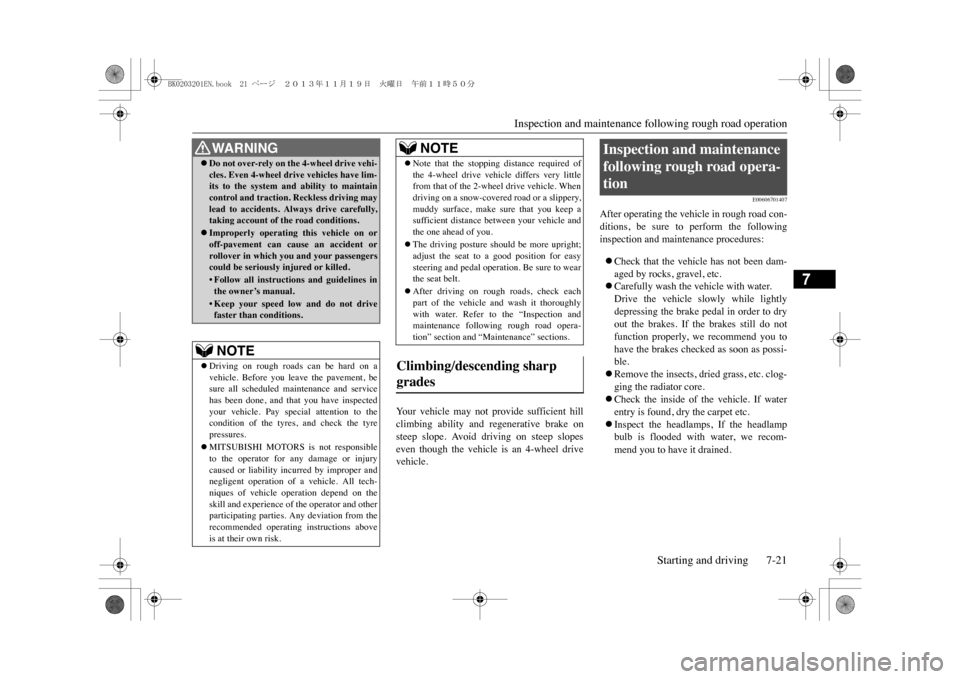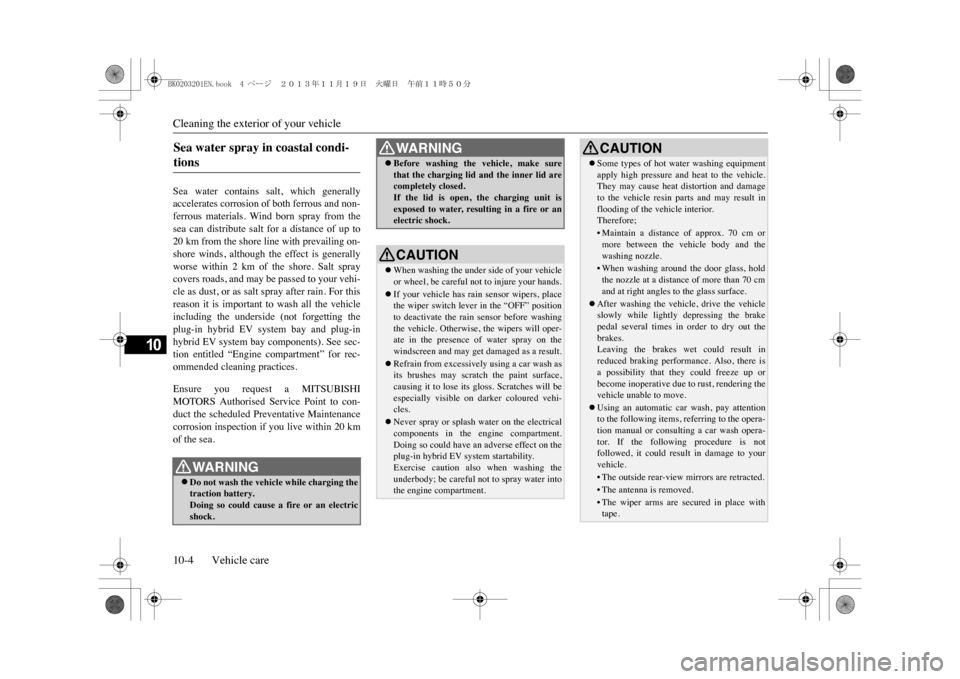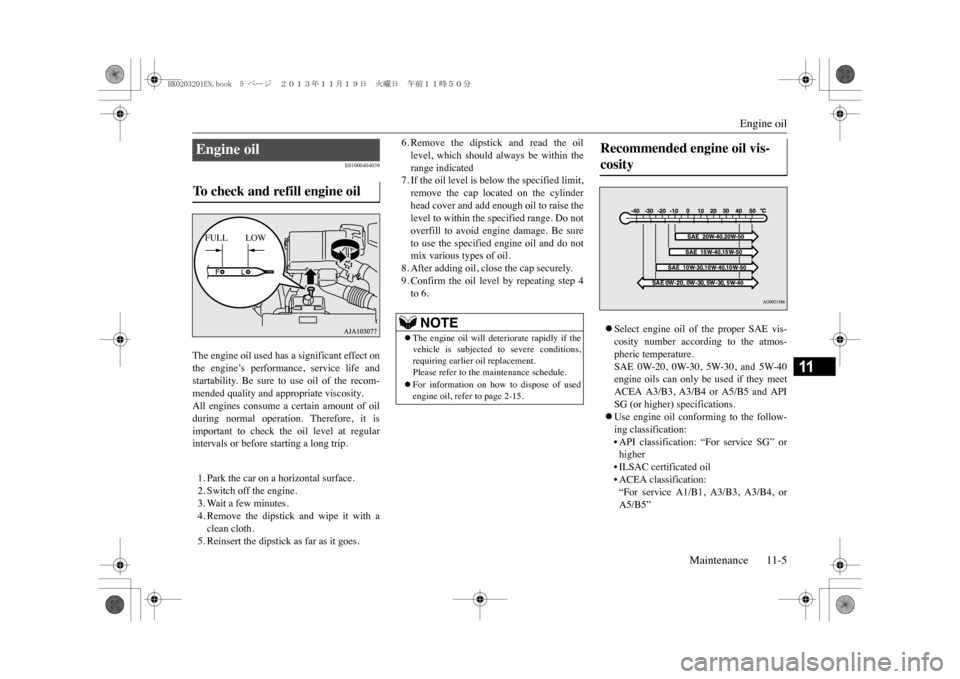2014 MITSUBISHI OUTLANDER SPORT service schedule
[x] Cancel search: service schedulePage 184 of 388

Inspection and maintenance following rough road operation
Starting and driving 7-21
7
Yo u r v e h i c l e m a y n o t p r o v i d e s u f f i c i e n t h i l lclimbing ability and regenerative brake onsteep slope. Avoid driving on steep slopeseven though the vehicle is an 4-wheel drivevehicle.
E00606701407
After operating the vehicle in rough road con-ditions, be sure to perform the followinginspection and maintenance procedures:�zCheck that the vehicle has not been dam-aged by rocks, gravel, etc.�zCarefully wash the vehicle with water.Drive the vehicle slowly while lightlydepressing the brake pedal in order to dryout the brakes. If the brakes still do notfunction properly, we recommend you tohave the brakes checked as soon as possi-ble.�zRemove the insects, dried grass, etc. clog-ging the radiator core.�zCheck the inside of the vehicle. If waterentry is found, dry the carpet etc.�zInspect the headlamps, If the headlampbulb is flooded with water, we recom-mend you to have it drained.
WA R N I N G�zDo not over-rely on the 4-wheel drive vehi-cles. Even 4-wheel drive vehicles have lim-its to the system and ability to maintaincontrol and traction.
Reckless driving may
lead to accidents. Always drive carefully,taking account of the road conditions.�zImproperly operating this vehicle on oroff-pavement can cause an accident orrollover in which you and your passengerscould be seriously injured or killed.•Follow all instructions and guidelines inthe owner’s manual.•Keep your speed low and do not drivefaster than conditions.NOTE
�zDriving on rough roads can be hard on avehicle. Before you leave the pavement, besure all scheduled maintenance and servicehas been done, and that
you have inspected
your vehicle. Pay special attention to thecondition of the tyres, and check the tyrepressures.�zMITSUBISHI MOTORS
is not responsible
to the operator for any damage or injurycaused or liability incurred by improper andnegligent operation of a vehicle. All tech-niques of vehicle operation depend on theskill and experience of the operator and otherparticipating parties.
Any deviation from the
recommended operating instructions aboveis at their own risk.
�zNote that the stopping
distance required of
the 4-wheel drive vehicle differs very littlefrom that of the 2-wheel
drive vehicle. When
driving on a snow-covered
road or a slippery,
muddy surface, make sure that you keep asufficient distance between your vehicle andthe one ahead of you.�zThe driving posture s
hould be more upright;
adjust the seat to a good position for easysteering and pedal operati
on. Be sure to wear
the seat belt.�zAfter driving on rough roads, check eachpart of the vehicle and wash it thoroughlywith water. Refer to the “Inspection andmaintenance following rough road opera-tion” section and “Maintenance” sections.
Climbing/descending sharp grades
NOTE
Inspection and maintenance following rough road opera-tion
BK0203201EN.book 21 ページ 2013年11月19日 火曜日 午前11時50分
Page 339 of 388

Cleaning the exterior of your vehicle10-4 Vehicle care
10
Sea water contains salt, which generallyaccelerates corrosion of both ferrous and non-ferrous materials. Wind born spray from thesea can distribute salt for a distance of up to20 km from the shore line with prevailing on-shore winds, although the effect is generallyworse within 2 km of the shore. Salt spraycovers roads, and may be passed to your vehi-cle as dust, or as salt spray after rain. For thisreason it is important to wash all the vehicleincluding the underside (not forgetting theplug-in hybrid EV system bay and plug-inhybrid EV system bay components). See sec-tion entitled “Engine compartment” for rec-ommended cleaning practices.Ensure you request a MITSUBISHIMOTORS Authorised Service Point to con-duct the scheduled Preventative Maintenancecorrosion inspection if you live within 20 kmof the sea. Sea water spray in coastal condi-tions
WA R N I N G�zDo not wash the vehicle while charging thetraction battery.Doing so could cause a fire or an electricshock.
�zBefore washing the vehicle, make surethat the charging lid
and the inner lid are
completely closed.If the lid is open, the charging unit isexposed to water, resulting in a fire or anelectric shock.CAUTION�zWhen washing the under
side of your vehicle
or wheel, be careful not to injure your hands.�zIf your vehicle has rain sensor wipers, placethe wiper switch lever in the “OFF” positionto deactivate the rain sensor before washingthe vehicle. Otherwise, the wipers will oper-ate in the presence of water spray on thewindscreen and may get damaged as a result.�zRefrain from excessively using a car wash asits brushes may scratch the paint surface,causing it to lose its gloss. Scratches will beespecially visible on da
rker coloured vehi-
cles.�zNever spray or splash
water on the electrical
components in the engine compartment.Doing so could have an adverse effect on theplug-in hybrid EV system startability.Exercise caution also when washing theunderbody; be careful not to spray water intothe engine compartment.WA R N I N G
�zSome types of hot wa
ter washing equipment
apply high pressure and
heat to the vehicle.
They may cause heat distortion and damageto the vehicle resin parts and may result inflooding of the vehicle interior.Therefore;•Maintain a distance of approx. 70 cm ormore between the vehicle body and thewashing nozzle.•When washing around the door glass, holdthe nozzle at a distance of more than 70 cmand at right angles to the glass surface.
�zAfter washing the vehicle, drive the vehicleslowly while lightly depressing the brakepedal several times in order to dry out thebrakes.Leaving the brakes wet could result inreduced braking performance. Also, there isa possibility that they could freeze up orbecome inoperative due
to rust, rendering the
vehicle unable to move.�zUsing an automatic car wash, pay attentionto the following items, referring to the opera-tion manual or consulting a car wash opera-tor. If the following procedure is notfollowed, it could result in damage to yourvehicle.•The outside rear-view mirrors are retracted.•The antenna is removed.•The wiper arms are secured in place withtape.CAUTION
BK0203201EN.book 4 ページ 2013年11月19日 火曜日 午前11時50分
Page 346 of 388

Engine oil
Maintenance 11-5
11
E01000404039
The engine oil used has a significant effect onthe engine’s performance, service life andstartability. Be sure to use oil of the recom-mended quality and appropriate viscosity.All engines consume a certain amount of oilduring normal operation. Therefore, it isimportant to check the oil level at regularintervals or before starting a long trip.1. Park the car on a horizontal surface.2. Switch off the engine.3. Wait a few minutes.4. Remove the dipstick and wipe it with aclean cloth.5. Reinsert the dipstick as far as it goes.
6. Remove the dipstick and read the oillevel, which should always be within therange indicated7. If the oil level is below the specified limit,remove the cap located on the cylinderhead cover and add enough oil to raise thelevel to within the specified range. Do notoverfill to avoid engine damage. Be sureto use the specified engine oil and do notmix various types of oil.8. After adding oil, close the cap securely.9. Confirm the oil level by repeating step 4to 6.
�zSelect engine oil of the proper SAE vis-cosity number according to the atmos-pheric temperature.SAE 0W-20, 0W-30, 5W-30, and 5W-40engine oils can only be used if they meetACEA A3/B3, A3/B4 or A5/B5 and APISG (or higher) specifications.�zUse engine oil conforming to the follow-ing classification:•API classification: “For service SG” orhigher•ILSAC certificated oil•ACEA classification:“For service A1/B1, A3/B3, A3/B4, orA5/B5”
Engine oil To c h e c k a n d r e f i l l e n g i n e o i l
FULL LOW
NOTE
�zThe engine oil will dete
riorate rapidly if the
vehicle is subjected to severe conditions,requiring earlier oil replacement.Please refer to the maintenance schedule.�zFor information on how to dispose of usedengine oil, refer to page 2-15.
Recommended engine oil vis-cosity
BK0203201EN.book 5 ページ 2013年11月19日 火曜日 午前11時50分